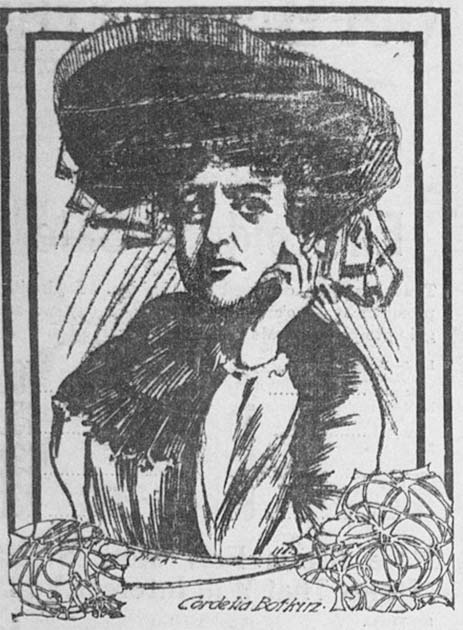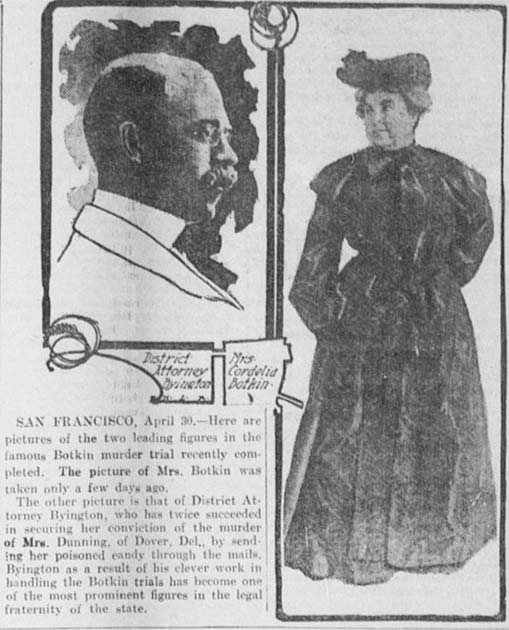In 1697, William Congreve immortalized the phrase “Hell hath no fury like a woman scorned”. But few women will take revenge so far as Cordelia Botkin.
Cordelia’s story is a chilling reminder of what happens when love turns into obsession and obsession turns into hate. Hers was a crime that sent shockwaves through early 20th-century America and will make you think twice before treating yourself to a chocolate.
Cordelia Botkin and the Affair
Cordelia Botkin was born in 1856 in Polk County, Missouri. Little is known about her youth except that at some point her family moved to California. In 1872, at the age of 18, she met and married Welcome Botkin.
The two moved to Stockton, California where they seemed to have lived a relatively normal life. Welcome worked as a grain broker and not long after they were married Cordelia gave birth to their son, Beverly. However, marital bliss was not on the cards for long.
Eventually, the two became separated, although they never officially divorced. Botkin moved to San Francisco while her estranged husband continued to support her. It was here that she met John Preston Dunning and where her deadly story really begins.
Botkin ran into Dunning while he was cycling in San Francisco’s Golden Gate Park. Despite the fact they were both married and Botkin at 41 was nearly a decade older than Dunning, the two quickly became infatuated.
Quite what Dunning saw in Botkin remains a mystery. He appeared to have everything going for him. He was a highly respected reporter for the Associated Press who had completed high-profile overseas assignments in both Samoa and Chile. Shortly before the two met he had been made superintendent of the Associated Press’s Western Division bureau in San Francisco.

He had also married well. He was married to Mary Elizabeth Penington-Dunning who was the daughter of Congressman John Brown and Rebecca Rowan Penington of Dover, Delaware. The young couple had a baby daughter Rebecca, and a charming home at 2529 California Street, in San Francisco.
Botkin on the other hand was separated, and was much older than Dunning. She liked to think she still cut a figure however, and used to brag about being photographed in over 100 poses, many of them quite saucy by Victorian standards.
- The Pimlico Poisoning Mystery: Adelaide Bartlett’s Perfect Crime?
- A Foiled Plot? How Churchill was Nearly Killed by a Chocolate Bomb
Whatever they saw in each other the two soon began an affair. Despite the fact they were both married they genuinely seemed to have been in love, with Dunning spending as much time as he could with Botkin.
This quickly raised his wife’s suspicions and in 1896 she left him, taking their daughter to live with her parents in Delaware. Dunning doesn’t seem to have been upset by this and soon he and Botkin were renting rooms in the same building.
The two do not seem to have been good for each other. While with Botkin, Dunning’s life began to unravel. He was a heavy drinker and gambler and not long after his wife left him, he was fired by the Associated Press after they realized he had embezzled $4000 in office funds to pay off his bookie. His career continued to nosedive as he lost jobs at newspapers in Salt Lake City and San Francisco due to his constant drunkenness.
The affair continued for three more years. Dunning eventually tired of Botkin’s companionship and began to pull himself together. In March 1898 he was re-hired by the Associated Press as their lead reporter and tasked with covering what would become the Spanish-American War.
His new position meant moving to Cuba and before leaving San Francisco he broke things off with a distraught Botkin, telling her that he would not be returning. He then reconnected and reconciled with his wife. While in Cuba Dunning’s redemption story continued with him helping to save survivors of the battleships that were sunk at the Battle of Santiago de Cuba on July 2, 1898.
Things may have been looking up for Dunning, but Botkin didn’t take the break-up well.
The Chocolate Box Murders
Botkin soon began plotting her revenge against the newly reunited couple. She began by sending numerous anonymous letters to Elizabeth Dunning, each detailing distinct aspects of her husband’s affair. She was only getting started.
Botkin recalled that Dunning had once told her that his wife was a big lover of candy and had a close friend who lived in San Francisco called Mrs. Corbaley. She used these two tidbits of information to plot the next phase of her revenge.
On August 9, 1898, Elizabeth Dunning received a small package at her parents’ house. That evening she dined with several members of the family including her parents, sister, brother-in-law, her nephew, and her daughter. After supper, the family sat on the veranda where Dunning finally got a chance to open her package.

It turned out to be an expensive-looking candy box containing a handkerchief, chocolate creams, and a note. All the note said was, “With love to yourself and baby. —Mrs. C. ” Elizabeth had no idea who “Mrs. C.” might be but wasn’t one to turn down candy.
Mrs. Dunning, her sister Ida Deane, and the pair’s children all began eating the gift. They also shared the sweets with two neighbors, Miss Millington, and Miss Bateman, who happened to walk past. That night they were all struck down with abdominal pains and heavy vomiting.
- Hubert Chevis and the Poisoned Partridge
- Titanic Thompson: The Golfer Who Married Five Women and Murdered Five Men
Tragically after two days of absolute agony, Mrs. Dunning and her sister died. It was found they had been killed by arsenic poisoning. Unfortunately for Botkin, it didn’t take long for Dunning’s family to start putting the dots together.
An Arrest
Congressman Penington examined the handwriting on the letter and quickly realized it matched the writing on the taunting letters his daughter had received weeks earlier. A local doctor, Dr. Wood, took no time to find the chocolates had been dosed with hefty amounts of arsenic.
John Dunning soon arrived in Dover having been told via telegraph of his wife’s death. He recognized Botkin’s handwriting immediately and recalled having told the toxic Botkin of his wife’s weakness for candy. He pointed the police in Botkin’s direction.
The local police sent Detective B. J. McVey to San Francisco with the candy box, handkerchief, and note. The murder of a congressman’s daughter was obviously a big deal, leading to San Francisco’s chief of police taking charge personally.
The police traced the chocolate to the candy store of George Haas under the Phelan block on Market Street. The two women who worked there not only positively identified Botkin but stated that she had requested a fancy, unmarked box and had told them not to fill the box completely because she had other items to add to it.
The handkerchief was also traced back to San Francisco’s “City of Paris” store. This didn’t take much detective work, Botkin had forgotten to remove the tag. The staff at this store also positively identified Botkin.

The final nail in Botkin’s coffin came when Mr. Frank Grey, a druggist employed at the “Owl” drug store told police he remembered selling Botkin the arsenic. She had said she planned on using it to bleach a straw hat and had insisted on buying it even when he had given her better options.
It was discovered that Botkin had fled to Stockton, California and detective B. J. McVey was dispatched to apprehend her. She was found living with her estranged husband and son but was arrested and brought to San Francisco to face the mountain of evidence against her.
Botkin’s trial was not a straightforward one. The problem was that she had shipped the poisoned candy from California, but it had been received in Delaware. This led to much arguing over jurisdiction and where Botkin should be tried. Botkin ended up being tried in both states and was found to be guilty twice.
She was ultimately sentenced to life imprisonment and died in San Quentin State Prison in 1910. Dunning, wracked with guilt and his career destroyed by the revelations that came out during the trial had died two years earlier, his life in tatters.
Top Image: Cordelia Botkin’s indiscriminate chocolate-based revenge saw her spend the rest of her life in prison. Source: torriphoto / Adobe Stock.